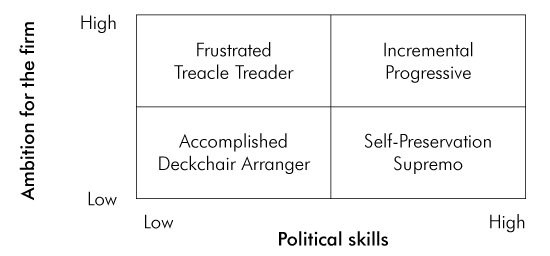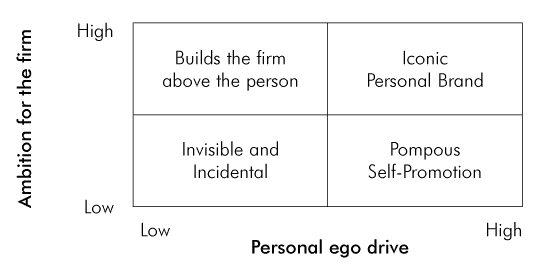Home » BLOG » Business Development » Some Observations on Law Firm Leaders
Some Observations on Law Firm Leaders
Published in Leadership Development in the Legal Profession
Over the past 20 years, I have observed a range of leaders and leadership styles in professional service firms. Over this same period, there has been an exponential increase of interest in the subject of leadership, and the crucial role that it plays in the success (and occasionally the failure) of law firms. This case study consolidates these observations and suggests a descriptive framework aimed at increasing understanding and effectiveness in this area.
For the purposes of this case study, the leader is defined more widely than simply the managing partner or senior partner, to encompass the heads of practice groups, the plateau equity partners and the members of the various committees, which make up the governance structure of firms.
Professional respect as a driver of behaviour
An important pre-qualification for anyone contemplating a leadership position is that they command the unquestioned respect of their peers. They must be a high-performing professional first if they are to be given the opportunity to earn their spurs as a leader. It may be illogical, but it is a truism of any professional service organisation.
At the same time, letting go of fee-earning work can be a real challenge in the transition to a leadership role. Such a step into the unknown represents a high-risk move – the gradual erosion of power, which emanates from key client relationships combined with the career limitations of immersing oneself in the management of a firm.
For some, this is avoided by simply treating the new role as a badge of honour or status, rather than an impingement on their fee-earning role. This is an opportunity lost, both for them and for the firm. My observation has been that others adopt one of a range of behaviours that define their tenure of leadership. These behaviours are described in more detail further in this case study.
Dimensions that shape behaviour
From the huge range of approaches and behaviours adopted by law firm leaders, a small number of traits can be distilled into a framework, which is both simple and useful. In particular, two pervasive and important dimensions rise to the surface. They are:
- Individuals’ ambition for the firm; and
- Individuals’ political skills.
From these, a model can be constructed which highlights four behavioural types, each of which is explained in more detail further in this case study.

The ‘Accomplished Deckchair Arranger’
This is the leader with negligible political ability and a low ambition for the firm. On the face of it, it is puzzling that such a psychotype could ever figure in an analysis of law firm leadership. In fact, there are many examples of the ‘Accomplished Deckchair Arranger’ prospering (and indeed being sought out as a future leader) in law firms everywhere. From the perspective of other partners, these types have two great advantages: they do the administrative work that no one else wants to do, and they don’t try to interfere with the status quo. They are harmless, likeable and non-threatening.
This quadrant is typified by the leader whose focus is on the operational efficiency of the firm’s back office. Their forays into management will impinge on practice areas, but only insofar as it does not affect the preferred working practices of the partner group.
While the ‘Deckchair Arrangers’ may have personal ambitions, their drive to develop their firm is not so great so as to risk confronting unhelpful behaviours. In other words, they are not political
animals. Without a strong cultural perspective and deep understanding of the political aspects of decision making dynamics that affect their firm, they will find themselves floundering.
This is not to say that the firm will not grow or be seen as ambitious from the outside. The key point is that, in this sort of organisation, ambition flows from individual partners and a culture which demands progress. Indeed, for some firms in this category, the collective will of the partnership acts against the election of anyone who may attempt to usurp their personal ambitions for one that is more cohesive and (necessarily) directional.
The ‘Frustrated Treacle Treader’
A second category of leaders is defined by the person with huge ambitions for their firm, but lacking the political wherewithal to take their firm forward with them. For these leaders, often operating in an analytical and logical fashion, the potential of the firm will be clear. Their route-map to lead the business to future success will be well-articulated. However, they will fail to bring people with them due to a poorly-tuned political or cultural antennae. With an inability to win hearts and minds through barnstorming inspiration or Machiavellian manipulation, they are often left to bemoan the general malaise that affects their colleagues.
Finding themselves mired in negotiations, filibustered at meetings and frustrated, they perceive a partnership ranged against them; doing everything possible to slow the rate of progress and minimise the impact of any changes on their personal position.
The ‘Treacle Treader’ has a view of the sensibilities and sensitivities of the partner group as a whole, and realises too late in their often short-lived reign, that raw ambition alone (even when coupled with a formidable intellect and determination to make progress), will never be enough to overcome a partnership steeped in historic norms.
The ‘Self-preservation Supremo’
Some leaders are all about self-preservation, and they have the political nous to see off all-comers. Their energies are focused on the maintenance of personal position more than the betterment of their firm. Young pretenders are seen off, and rivals are ring-fenced before being exited, while non-submissives are ostracised.
Over time, they exert an iron-grip of control, which is reinforced by the stories and folklore of the organisation recounting the demise of those who have been challenged in the past.
Fawning acolytes reinforce the position of these benevolent dictators whose firms or practice groups seldom prosper, but seldom crash either. They simply bumble along, underperforming their apparent peers, but surviving nonetheless in a steady sort of way.
In truth, this is the most damaging behavioural type for the long-term future of the firm, because these leaders have tremendous staying power. They may not be the right person for the job (and this may be clearly apparent to everyone involved), but they take some shifting.
The ‘Incremental Progressive’
Those who have a strong ambition for their firm, and the political wherewithal to make things happen, may be regarded as ‘Incremental Progressives’. They recognise that movement towards the end goal which they envision will take time; it will be as a result of steely determination combined with an acceptance of incremental progress. The critical path is defined by the need to maintain consensus and commitment, rather than focus on rational investment profile or Gantt chart analysis.
Yet, it is the ‘Incremental Progressive’ who has the intellectual and personality tools to make real and enduring changes within their firm, to build a string brand, and to provide a legacy for their successors. Their combination of ambition and political sense means that they are able to glide over the treacle that so encumbers the less savvy yet ambitious, but without stooping into the self-aggrandising approach of those focused on the perpetuation of their personal position.
Can ambition and ego be comfortable bedfellows?
Turning to the issue of ambition and the impact that this can have on effectiveness of the leadership function, it is instructive to consider some of the academic research that has been carried out into the behaviour of great leaders. One of the seminal papers in the field is ‘Level Five Leadership: The Triumph of Humility and Fierce Resolve’, by Jim Collins (published in Harvard Business Review, July/August 2005). Collins’ study illustrates that the very best leaders (those at level five in his model) have an unusual (and in many ways paradoxical) blend of personal humility and professional will that allows them to build great and enduring organisations.
So what are the implications of this research for law firms? By mapping ambition for the firm against personal ego drive, it is possible to construct a model, which helps to explain how these traits can impact on the personal brand of the leader, as well as the likely success of the firm.
Of course, the reader with knowledge of the market will be able to think of law firm leaders who could be placed in each of the quadrants, but the purpose of this article is not to poke fun or embarrass, but to highlight the impact of these traits on the current and future success of the business.

‘Invisible and Incidental’
The ‘Invisible and Incidental’ leaders are most notable for their anonymity, and act as fringe players, played out by the ‘super egos’ in their firm or practice group.
For their organisations, success or failure happens in spite of their presence, rather than because of any active involvement that they have had in shaping its future direction and driving its implementation.
‘Pompous Self-Promoters’
Law firms are, unfortunately, replete with ‘Pompous Self-Promoters’. Armed with a huge ego, they will view leadership as a platform from which to broadcast, even more widely, their own self-importance. For many in this quadrant, promotion of self can only be achieved by the belittling of others; consequently, their term of leadership is characterised by division and malcontent.
Smart firms now recognise that there can be no place for these personalities in their leadership teams, regardless of their abilities as lawyers, if the firm is to prosper in the longer term.
‘Iconic Personal Brand’
‘I’m great and the firm’s great – with me at the helm we can be even greater!’ This typifies the approach of the ‘Iconic Personal Brand-Builder’.
Be under no illusions that leaders in this quadrant can be phenomenally successful. They have ambition for the firm squarely in their sights.
The longer-term question for the organisation is how much of this success is viewed as ‘stand-alone’, and how much is inextricably linked to the persona of the leader. Confidence (both individual and collective) is an important issue in driving the performance of a law firm; a misplaced belief that success can only be achieved with the current leader can be a huge impediment to progress in the early days of any subsequent regime.
The question is always, ‘What happens next?’ The smart organisation has an eye to succession planning in advance of any impending changes. Continued success of the firm will only be secured if the next incumbent is well prepared and equipped to take the business to the next level of its development.
Builds the firm above the person
This is a leader, analogous to the level five personality, who will position the performance of the firm above any personal contribution that they have made. Combined with ambition to drive the firm forward and the nous to navigate the shark-infested political waters ahead, this leader has the potential to make a significant and enduring difference to the future success of their firm.
That is not to say that such leaders will be invisible to the outside world either. In the intrusive and media-heavy world in which law firms operate, they will become known and respected. They will rise to their responsibilities to engage with external media without treating such a platform as their personal ‘soap-box’. They will always (and genuinely) place praise for success at the door of their people and their clients, not because their PR advisers tell them that this is what they should do, but because they genuinely believe it to be the case.
Where next for law firms and their leaders?
The challenges facing the leaders of law firms have never been greater, and as a corollary, the impact that great leaders can have on the future of their firms cannot be overstated. Recognition of the way in which a leader’s behaviour can impact on the performance and long-term health of their firm is crucial.
Collective action is needed from the wider governance team to ensure that potential leaders with the required personality traits and behaviours are given the opportunity to develop and utilise their talents, in order to take their firm forward.
This article was published in November 2008 in Leadership Development in the Legal Profession. To read the original article click here.
You may also like
Search
Categories
Recent Posts
- Fighting fit
- The Challenges Of Leadership Are Different To The Challenges Of Management
- The Cultural Dimensions Of Leveraging Institutional Knowledge
- A knowledge-led approach to business development is key to law firm resilience
- Team Morale Is Directly Linked To The Ability To Deliver Differentiated Client Services
